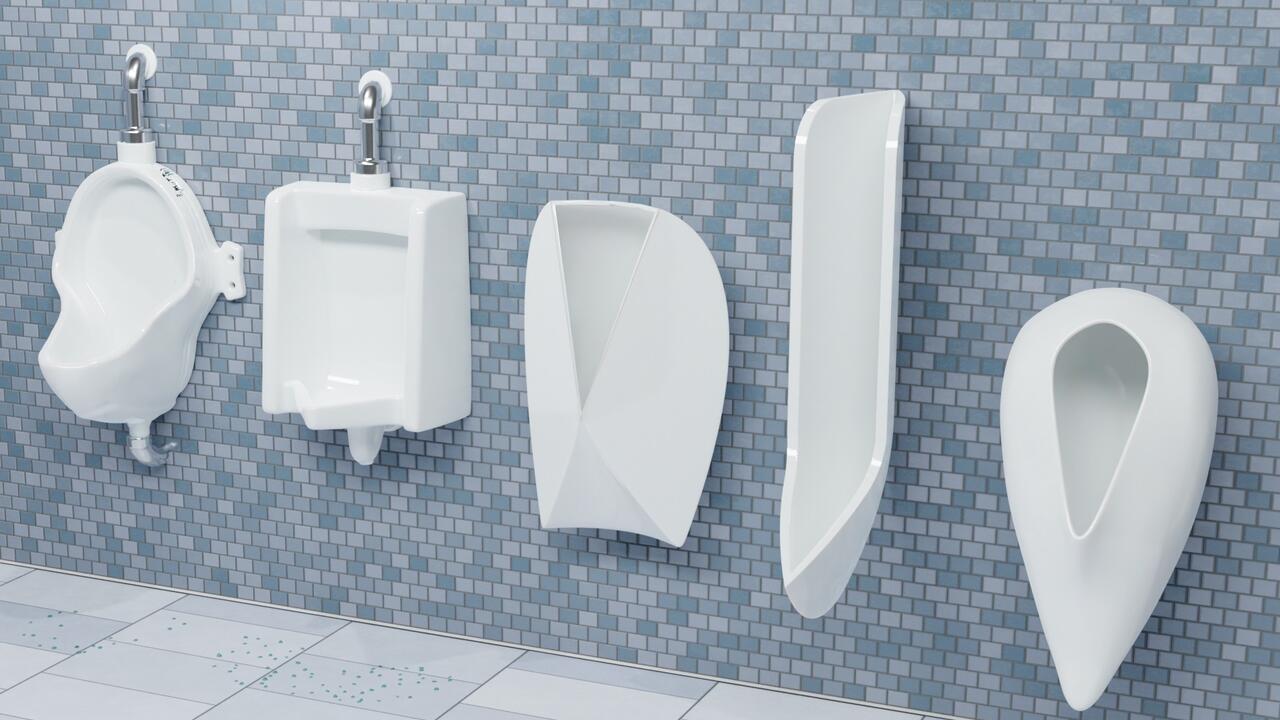
Solving a messy problem
Engineering researchers make a media splash with sleek new 'splash-free' urinal design

Engineering researchers make a media splash with sleek new 'splash-free' urinal design
By Brian Caldwell Faculty of EngineeringEngineering researchers at the University of Waterloo followed their curiosity and called on nature for inspiration for a new urinal design that has attracted international attention by solving the messy problem of splash-back.
The long, sleek design all but eliminates splatter on floors and shoes by ensuring the angle at which a urine stream hits the urinal wall doesn’t exceed about 30 degrees, a measurement determined via physical experiments and computer modelling.
“We found that when a liquid jet or droplet train impacts a rigid surface below a certain critical impinging angle, almost no splatter is generated,” the researchers wrote. “Thus, a surface designed to always intersect the urine stream equal to or smaller than the critical angle prevents splash-back.”

Researchers designed this urinal to all but eliminate messy splash-back.
Conducted by a team of professors and students at Waterloo and Weber State University in Utah, the study that produced the new design has made news in multiple languages since the results were presented at a recent American Physical Society conference in Indianapolis.
Dr. Zhao Pan, a professor of mechanical and mechatronics engineering at Waterloo who led the project over the course of several years, said the response has been particularly gratifying because much of the work was done by undergraduate students in his lab.
“This urinal design project is the best teaching tool I can think of, as it is a daily-life problem that covers numerous topics – including fluid mechanics, sustainability, differential equations, manufacturing and prototyping, art, industrial design, human factors, bio-mechanics and testing,” he said.
The conference presentation, in fact, was handled by undergraduate Kaveeshan Thurairajah, who worked on the study for about two years and is now in his final year of the mechanical engineering program.
Although the approach to the subject matter was lighthearted and his talk generated a lot of laughs, he said the project required plenty of serious work and taught him lessons no classroom instruction ever could have.
“What makes research rewarding and drives discovery is finding a nut to crack, one which has slipped the eyes of those before us,” Thurairajah said.
Inspiration for the new urinal design came from the way dogs lift their hind legs to urinate against trees, a behaviour that instinctively minimizes the impact angle, and the curving structure of nautilus shells.
The result is a “splash-free urinal” with a special narrow opening and a curved inner surface designed to prevent droplets from flying out regardless of how tall the user is or where he aims.
“Our new urinal designs will keep bathrooms cleaner and reduce the labor, water, and chemicals required for periodic cleaning to promote more sustainable bathroom maintenance,” the researchers wrote.
The project involved tests with jets of coloured fluids at different speeds and heights with five urinals, including a widely used North American urinal, a replica of a famous sculpture by modern artist Marcel Duchamp and three original designs.
Their effectiveness was measured by wiping the splattered mess with a paper towel after each experiment and weighing it to determine the mass of liquid picked up.
“The idea for this project truly originated – well, exactly where you think it did,” said Pan, director of the Pan-Lab for fluid physics. “When you study fluid behavior all day, you can't help but wonder about these everyday scenarios. The fun part is that we are solving a real-world problem affecting 50 per cent of humans.”
The research team also included Waterloo students Mabel Song and JD Zhu, and Dr. Randy Hurd and student Ethan Barlow of Weber State.

Read more
Here are the people and events behind some of this year’s most compelling Waterloo stories

Engineering master's student Nayeema Nonta (left), one of the three paper authors, and her supervisor, Dr. Sirisha Rambhatla, in a large server room with the computer power needed to develop their new LLM training technique. (University of Waterloo)
Read more
Waterloo researchers develop highly efficient AI training system that paves the way for cheaper, greener “intelligent partners”

Read more
Engineering researchers team up to tackle the plastics pollution problem with microbial innovation and engineering design
The University of Waterloo acknowledges that much of our work takes place on the traditional territory of the Neutral, Anishinaabeg, and Haudenosaunee peoples. Our main campus is situated on the Haldimand Tract, the land granted to the Six Nations that includes six miles on each side of the Grand River. Our active work toward reconciliation takes place across our campuses through research, learning, teaching, and community building, and is co-ordinated within the Office of Indigenous Relations.